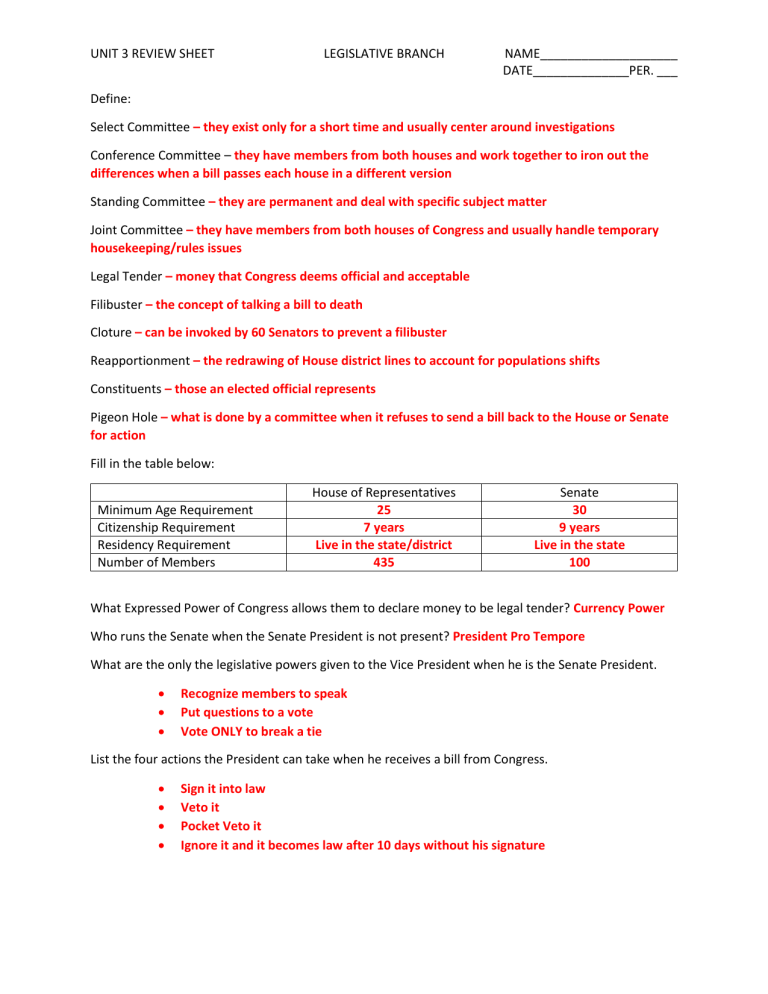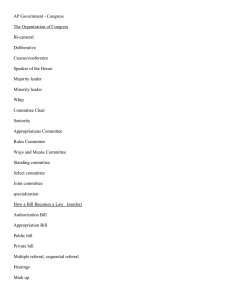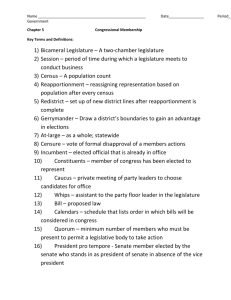Unit 3 Review Sheet with answers

UNIT 3 REVIEW SHEET LEGISLATIVE BRANCH NAME____________________
DATE______________PER. ___
Define:
Select Committee – they exist only for a short time and usually center around investigations
Conference Committee – they have members from both houses and work together to iron out the differences when a bill passes each house in a different version
Standing Committee – they are permanent and deal with specific subject matter
Joint Committee – they have members from both houses of Congress and usually handle temporary housekeeping/rules issues
Legal Tender – money that Congress deems official and acceptable
Filibuster – the concept of talking a bill to death
Cloture – can be invoked by 60 Senators to prevent a filibuster
Reapportionment – the redrawing of House district lines to account for populations shifts
Constituents – those an elected official represents
Pigeon Hole – what is done by a committee when it refuses to send a bill back to the House or Senate for action
Fill in the table below:
Minimum Age Requirement
Citizenship Requirement
Residency Requirement
Number of Members
House of Representatives
25
7 years
Live in the state/district
435
Senate
30
9 years
Live in the state
100
What Expressed Power of Congress allows them to declare money to be legal tender? Currency Power
Who runs the Senate when the Senate President is not present?
President Pro Tempore
What are the only the legislative powers given to the Vice President when he is the Senate President.
Recognize members to speak
Put questions to a vote
Vote ONLY to break a tie
List the four actions the President can take when he receives a bill from Congress.
Sign it into law
Veto it
Pocket Veto it
Ignore it and it becomes law after 10 days without his signature
UNIT 3 REVIEW SHEET LEGISLATIVE BRANCH NAME____________________
DATE______________PER. ___
When does reapportionment occur? Why is it necessary? Reapportionment occurs every 10 years after the census. It’s necessary to adjust representation to better represent population shifts
Next to each Expressed Power of Congress below, explain why they were given that power.
Lay and Collect Taxes to maintain the military and properly run our government
Borrow money to be able to run the government even if they don’t collect enough tax money
Regulate interstate and foreign trade to protect domestic (home) industries and maintain foreign policy
Make naturalization laws to allow immigrants to become citizens but also ensure they are the quality of citizen we need (not convicted criminals)
Coin and print money – to maintain currency value and stabilize the economy
Fix the standard of weights and measures – to ensure quality of products and fairness of prices
Establish Post Offices and Post Roads – to ensure quality mail delivery
Issue Copyrights and Patents to protect and promote intellectual property and original ideas
Make courts below the Supreme Court – to ensure that our judicial system runs smoothly
Define and punish piracies and felonies committed on the high seas – to maintain quality of and safety for those traveling by sea
Declare war – to ensure checks and balances – one man (President) or a group
(Supreme Court) cannot get all upset and get us into a war. Congress would debate it then make the decision
Raise and support an Army and a Navy – to protect our citizens and interests at home and abroad
Call into action state militias – now called the National Guard – to maintain order at home during a crisis and aid our troops abroad when needed
Govern territories of the United States – to act as the government of areas where state governments don’t exist, but interests need protecting
What is the job of the majority and minority whips?
To assist their respective Floor Leaders in their jobs
Why should Congressmen maintain contact with their constituents back home?
To ensure proper representation of their concerns and interests
How does the fact that we elect our Congressmen represent the Constitutional principles of Popular
Sovereignty and Republican form of gov’t?
The fact we get to CHOOSE is popular sovereignty and the fact that one person represents the interests of those who voted them into office represents a
Republican form of government (Representative Democracy)
What is the MAIN job of the Legislative Branch of our government?
Make the laws
What is the fraction of votes from each house needed to override a Presidential veto?
2/3rds
UNIT 3 REVIEW SHEET LEGISLATIVE BRANCH NAME____________________
DATE______________PER. ___
The President can appoint people to several different positions, which ones need Senate approval?
Ambassadors/Diplomats
Federal Judges & Supreme Court Justices
Heads of the Executive Departments
Explain why revenue-raising bills must originate in the House of Representatives.
They represent a smaller, more cohesive/like-minded set of constituents than Senators AND the Constitution gives them the sole power to make tax laws
List the three actions taken by a subcommittee once it receives a bill for further investigation.
Investigate
Debate it
Recommend its fate
List the five actions a committee may take once it receives a bill from the subcommittee.
Recommend it favorably
Recommend it unfavorably
Refuse to recommend it (pigeon hole it)
Recommend it with amendments
Recommend a whole new bill
How is the Chairman of a committee chosen?
By the committee members from the majority party
Why is the Ranking Member of a committee important?
They are in charge of the committee when the chairman isn’t there
Who is the most powerful person in the House of Representatives?
Speaker of the House
Who is the most powerful person in the Senate?
Majority Leader
What person/group determines the date and debate time for bills on the floor of the House?
House
Rules Committee
What person/group determines the date for bills to be debated on the floor of the Senate?
Majority
Leader
List the steps in a bill becoming a law.
1.
Introduced, given a name and number
2.
Sent to committee
3.
Sent to subcommittee
4.
Sent back to the floor
5.
Voted on
6.
If passed, goes to next house
7.
Repeat steps 1-6
8.
If passed in different version, goes to Conference Committee
9.
Conference Committee comes up with a compromised version
UNIT 3 REVIEW SHEET
10.
Goes back to both house floors
11.
Voted on
12.
If passed goes to the President
Flashback section – know the Bill of Rights
LEGISLATIVE BRANCH NAME____________________
DATE______________PER. ___
Short answer topic: Be able to explain the process of impeachment and how it relates to checks and balances.








